How to Freeze Broccoli
This post may contain affiliate links, which means that I may receive a commission if you make a purchase using these links. As an Amazon Associate I earn from qualifying purchases.
Having plenty of prepared broccoli in the freezer makes it easy to grab a handful to use in recipes. You can add frozen broccoli to soups, stir-fries, and casseroles. Learn how to freeze broccoli to preserve it for future meals.
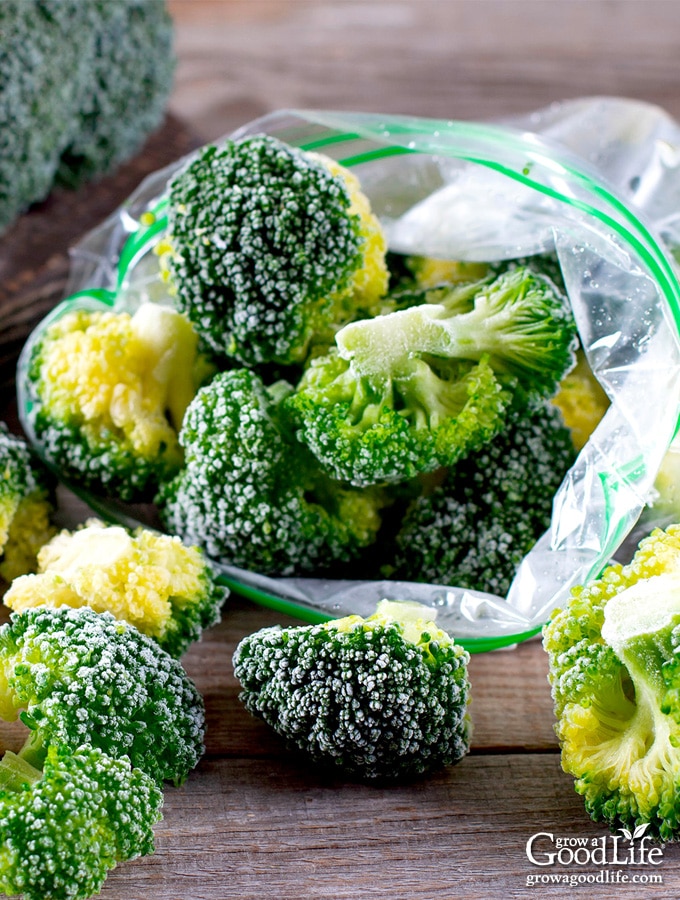
Broccoli is a great vegetable to have on hand for nutrition, flavor, versatility, and quick cooking time. The part of the broccoli we eat is actually the flower head that is harvested just before it blooms.
Growing broccoli is a test of patients. Most varieties need 70 to 100 days to reach maturity when started from seed under lights indoors and transplanted to the garden. If you are growing a number of plants, they can mature at different times, or be ready to harvest all at once.
Once you spot a crown beginning to form in the center of the plant, you need to keep an eye on it. You want the crown to grow as large as it can, but you want to harvest it while buds are tightly closed before they bloom.
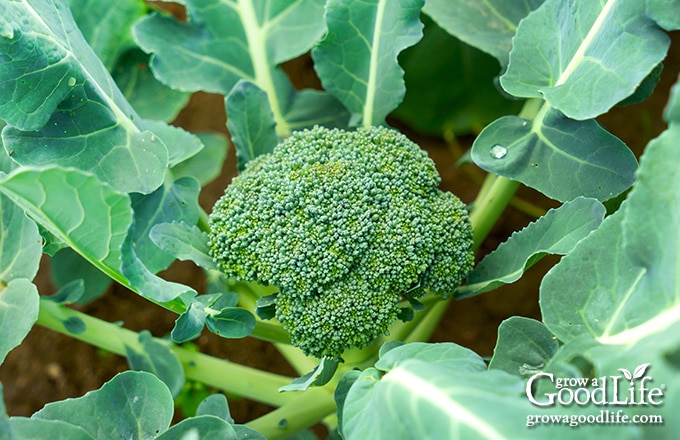
Loose heads and yellowing are signs that the broccoli is about to blossom. Harvest immediately, because once the buds open, the broccoli will have a bitter flavor and mealy texture.
While broccoli florets are the favorite, all parts of the plant can be eaten including the stems and leaves.
The stalks have a woody outer layer, but the center of the stems can be exposed with a little trimming. Use a vegetable peeler to slice off the outer fibrous skin, and then cut the stems into chunks and blanch and freeze separately, or right along with the florets.
The leaves can be used the same way you would enjoy kale or cabbage, such as raw in salads, briefly cooked, or chopped and added to a soup or stir-fry. You can also toss the leaves and stems in a vegetable scrap freezer bag to make homemade stock later.
Steps to Freezing Broccoli
Whether you have an abundant harvest of broccoli from your garden, stocked up at the grocery store, or stumbled on a great deal at the farmers’ market, you can preserve broccoli by blanching and freezing.
A detailed printable recipe can be found at the bottom of this article, but here are the steps to blanch and freeze broccoli:
Step 1: Harvest at Peak or Select Healthy Crowns
Harvest mature broccoli once the heads have sized up, are still tight, and before flower buds open. Pick broccoli in the early morning when the plants are hydrated and cool from the night air. Use a sharp knife or clean pruning shears to cut the main head off the plant along with several inches of the stalk. The plant will continue to produce side shoots with smaller heads of broccoli for a later harvest.
If you are picking up broccoli to preserve, choose broccoli crowns that look fresh, feel firm, and have a deep green color. Avoid crowns that are loose, yellow, or brown. Also skip the ones with shriveled leaves and dried out stems. These are signs that the broccoli has been hanging around for a while and may not be the best quality to preserve.
Step 2: Gather Your Equipment
Common kitchen equipment you will need to freeze broccoli:
- Large bowl
- Large pot
- Colander or mesh strainer
- Knife
- Cutting board
- Slotted spoon
- Baking sheets
- Parchment paper
- Zipper type freezer bags
- Kitchen towels
Step 3: Soak the Broccoli in Salted Water
Rinse the broccoli well under clean running water to remove dust and dirt from the surface. Broccoli’s nooks and crannies make it difficult to rinse off worms and bugs. Soaking the broccoli in salty water will kill and help dislodge any unwanted guests.
Make a salt bath by combining 1 gallon of water with 4 teaspoons of salt in a large bowl.
Prepare the broccoli by removing the leaves and trimming off the bottom woody stems. Divide the broccoli crown into pieces that are about 2-inches in size, place them in the salt water, and soak for about 30 minutes. Swirl the pieces around to dislodge debris. Drain and rinse well under running water before blanching.
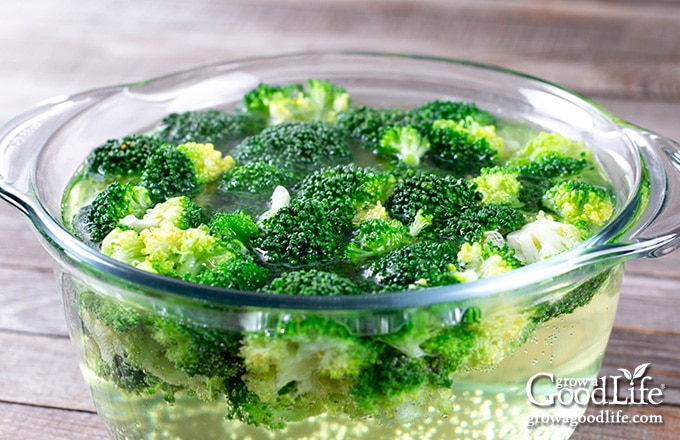
Save the leaves and stems for another use, or if you wish to freeze the stems, peel off the woody outer layer with a vegetable peeler, cut into 2-inch pieces, and blanch and freeze separately or right along with the broccoli florets.
Step 4: Blanch the Broccoli
Blanching in boiling water partially cooks the broccoli. This helps slow the enzymes that cause lost flavor, color and texture. Blanching also washes off any microorganisms that might be on the surface.
Bring a large pot of water to a boil over high heat. While the water is heating up, prepare an ice bath by filling a large bowl full of ice and cold water.
Once the pot is boiling, add the broccoli pieces and boil for 3-minutes.
Remove the broccoli from the pot and place in the bowl of ice water to cool for about 5 minutes. Once the broccoli has cooled, scoop it out and dry on a clean kitchen towel.
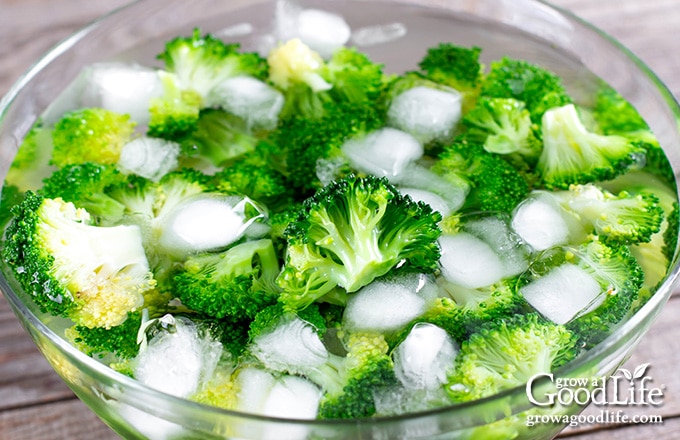
Step 5: Quick Freeze the Broccoli
Flash freezing the broccoli before storing in freezer bags will help prevent the pieces from sticking together and allow you to grab a handful when needed.
Let the broccoli dry, place it in a single layer on a parchment-lined baking tray, and freeze until solid, about an hour.
Step 6: Package into Freezer Bags
Place the frozen broccoli into freezer bags, remove the air, and seal the bag. Label, date, and store in the freezer until you are ready to use in your favorite recipes. Properly blanched, packaged, and frozen broccoli will last for up to 12 months.
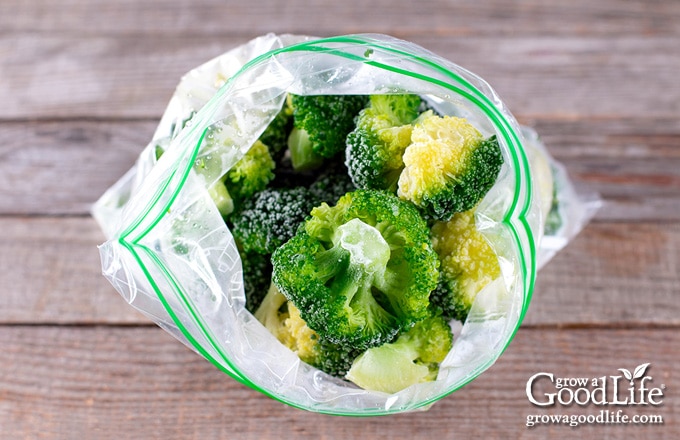
Ways to Use Frozen Broccoli
Frozen broccoli can be used the same way as fresh broccoli in any cooked meal, such as oven roasted, steamed, or sautéed. Frozen florets can be added by the handful to soups, casseroles, and stir-fries. When boiling pasta, add frozen broccoli to the pot the last few minutes and toss with your favorite sauce.
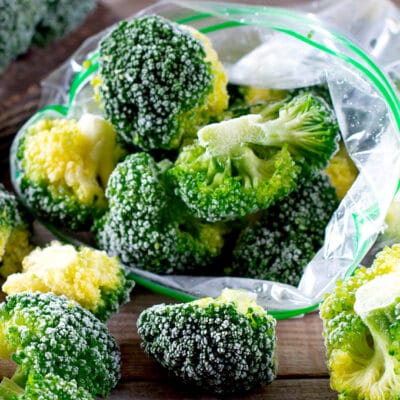
How to Freeze Broccoli
Ingredients
- 1 pound broccoli
- 2 gallons water divided
- 4 teaspoons salt
- ice
Instructions
- Rinse the broccoli well under clean running water to remove dust and dirt from the surface.
- Cut the broccoli into 2-inch pieces.
- Combine 1 gallon of water and the salt in a large bowl.
- Place the broccoli pieces in the salt water, and soak for about 30 minutes.
- After soaking, drain and rinse the broccoli well under running water before blanching.
- Fill a large bowl with the remaining gallon of water and ice.
- Bring a large pot of water to a boil over high heat.
- Once the water is boiling vigorously, lower the broccoli pieces into the pot and boil for 3-minutes.
- Remove the blanched broccoli and plunge it into the bowl of ice water to cool for about 5 minutes.
- Once the broccoli florets have cooled, remove them from the ice water and place on a clean kitchen towel to absorb extra moisture.
- Line baking sheets with parchment paper, and arrange the pieces on the trays so they are not overlapping.
- Place the baking sheets in the freezer and freeze until the broccoli is solid, about 1 to 2-hours.
- Transfer the frozen broccoli to freezer bags, squeeze to remove air, and seal the bag. Label, date, and store the frozen broccoli in the freezer until ready to use in your favorite recipes. Use within 10-12 months.
Nutrition
You May Also Like:
Good planning is key to a successful vegetable garden
Whether you are new to growing your own food or have been growing a vegetable garden for years, you will benefit from some planning each year. You will find everything you need to organize and plan your vegetable garden in my PDF eBook, Grow a Good Life Guide to Planning Your Vegetable Garden.


Hello,
The freezing was the easy part. However, how can you cook frozen broccoli? I put mine in the oven to roast, but they steamed and got mushy. I did not defrost them because that also produces lots of water. Any help would be great.
Thank you.
Laura, Great point. Roasting frozen broccoli is a little tricky because of the extra moisture. A great tip I learned is to roast broccoli on a preheated baking sheet at a high heat. Place the baking sheet in the oven, and preheat to 425˚F. When you add the frozen broccoli to the preheated sheet, the ice crystals will melt and the heat will evaporate extra moisture. Drizzle oil, season, and spread out the broccoli so it isn’t overcrowded. Pop in the oven and roast until the edges brown slightly.